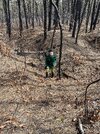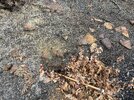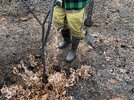Ron (Rooftree) had noticed an old symbol for a mine on the subject topo map, and it’s also on the 1885 Cook Topo Map. The mined area is in Bass River Township, about 2 miles northwest of Lake Absegami.
Ron visited the site with a friend, and I visited the site yesterday with him, as I was interested in this concept of ‘inverted topography’ inherent in our coastal plain. Here at this mine, they took out sandstone for various uses. Probably for chimneys, foundations, walls, and whatever. They had no other handy source for rock back then. When we got there, I was surprised to see how much they actually dug out. I don’t suppose they had heavy machinery back in the 1800’s, likely just mules and hand tools.
I have no knowledge of geology (regrettably), so I had the urge to read up on how the sandstone came to be found on hills such as this. I tried reading some professional papers but my mind got foggy. I did find a more digestible explanation in a newsletter put out by the New Jersey Geological Survey, Department of Environmental Protection.
Very basically, these deposits were laid down by old river courses 8 to 10 million years ago as they washed across our flat coastal plain after the oceans receded. Further along in time, local streams cut river valleys around these harder deposits and the old river bottoms became our hills and ridges of sandstone. I think it would be great if a geologist and an artist got together and portrayed this sequence of events graphically. I tried to simplify it so I could understand it better, I may not have it right, so here below you can read it yourself.
v1n2.pdf (nj.gov)
This is a neat place to take your kids and give them a basic understanding of why this happened while they run around in the holes exploring. Not easy to get to if you don't drive in the woods often, but the sand roads make hiking easy. You should use a GPS.
PS: I use the term for this aggregate as sandstone for convenience only because I don't know the formal name for what I assume to be termed "Beacon Hill" deposits.


The large set of diggings I've circled are about 500 feet long by 100 feet wide. Photos will follow in next post.

Ron visited the site with a friend, and I visited the site yesterday with him, as I was interested in this concept of ‘inverted topography’ inherent in our coastal plain. Here at this mine, they took out sandstone for various uses. Probably for chimneys, foundations, walls, and whatever. They had no other handy source for rock back then. When we got there, I was surprised to see how much they actually dug out. I don’t suppose they had heavy machinery back in the 1800’s, likely just mules and hand tools.
I have no knowledge of geology (regrettably), so I had the urge to read up on how the sandstone came to be found on hills such as this. I tried reading some professional papers but my mind got foggy. I did find a more digestible explanation in a newsletter put out by the New Jersey Geological Survey, Department of Environmental Protection.
Very basically, these deposits were laid down by old river courses 8 to 10 million years ago as they washed across our flat coastal plain after the oceans receded. Further along in time, local streams cut river valleys around these harder deposits and the old river bottoms became our hills and ridges of sandstone. I think it would be great if a geologist and an artist got together and portrayed this sequence of events graphically. I tried to simplify it so I could understand it better, I may not have it right, so here below you can read it yourself.
v1n2.pdf (nj.gov)
This is a neat place to take your kids and give them a basic understanding of why this happened while they run around in the holes exploring. Not easy to get to if you don't drive in the woods often, but the sand roads make hiking easy. You should use a GPS.
PS: I use the term for this aggregate as sandstone for convenience only because I don't know the formal name for what I assume to be termed "Beacon Hill" deposits.
The large set of diggings I've circled are about 500 feet long by 100 feet wide. Photos will follow in next post.
Last edited:





